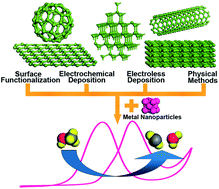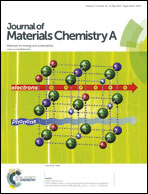Recent progress on carbon-based support materials for electrocatalysts of direct methanol fuel cells†
Abstract
With the continuously increasing demand of energy along with depletion of conventional fossil fuel reserves and the rapidly escalating environmental problems, direct methanol fuel cells (DMFCs) as alternative green and sustainable power sources have aroused tremendous research interest in academic and engineering circles. In order to achieve high power density as well as low production cost of DMFCs, the well-designed and fabricated anode catalysts with controllable composition, architecture and morphology have been regarded as a key point for realizing high-performance. In this aspect, carbon materials, as building blocks, offer a great potential to play a key role in constructing advanced hybrid catalysts due to their exceptional physicochemical properties, such as high specific surface area, superior electronic conductivity, excellent stability and so on. This review summarizes the recent significant progress in the design and fabrication of novel carbon-based anode catalysts via various strategies and their applications in methanol oxidation reaction. Finally, perspectives on the challenges and research trends in this emerging area are also discussed.

- This article is part of the themed collection: 2014 Journal of Materials Chemistry A Hot Articles

 Please wait while we load your content...
Please wait while we load your content...